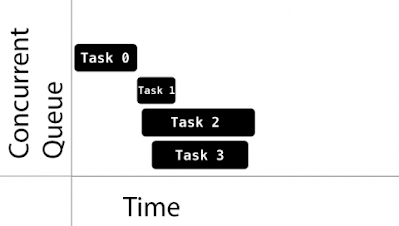Dispatch Queue
GCD provides Thread Safe one Dispatch Queue to perform Multi-threading operations. All Dispatch Queues are FIFO data structures. Therefore, the task always starts in the order in which it was added.
Serial(main)
Serial queues are serial queues that process them one by one in the order in which they were added to the queue. One Task must be completed to process the next Task.
Concurrent(global)
Component queues are parallel queues that execute multiple operations at the same time. Task runs in the order in which they were added to the queue. The number of tabs that can be run at once is variable and depends on system conditions. Global Queue provides quality of service (QOS)for prioritizing tasks.
When sending tasks to global concurrent queues, they do not specify a direct priority. Instead, specify a Quality of Service (QOS) class property: this indicates the importance of the task and helps the GCD determine the priorities to assign to the task.
Sync, Async
Sync (synchronous)
After the thread registered with the queue is finished, run the next queue sequentially.
Async (asynchronous)
The threads registered in the queue do not wait until the end of the operation, and the next queue is run sequentially and simultaneously. The end of a task is not sequential and can vary from task to task. The difference is whether to wait until one task is completed and then run the next. In the case of Sync, you should use Async because you can't do anything if you use it if it takes a long time or you're uncertain when it's going to be done. Depending on which queue uses synchronous asynchronous, you can use it as follows:
- Serial
- Sync
- Async
- Concurrent
- Sync
- Async
Using Dispatch Queue
Create DispatchQueue
// Serial Queue DispatchQueue.main.sync { } // CRASH! DispatchQueue.main.async { } DispatchQueue(label: "com.CustomSerialQueue").sync { } DispatchQueue(label: "com.CustomSerialQueue").async { } // Concurrent Queue DispatchQueue.global().sync { } DispatchQueue.global().async { } DispatchQueue(label: "com.CustomConcurrentQueue", attributes: .concurrent).sync { } DispatchQueue(label: "com.CustomConcurrentQueue", attributes: .concurrent).async { }
DispatchQueue.main.sync If you use , you will get an error. The reason for this is that if you sync to the main queue while working on the main queue and block it, you will fall into a deadlock. If you synchronise serial queues, you can create and use custom queues rather than main.
Serial queue - Sync
Because other tasks are blocked until the end of the queue's work, one operation must be completed before the other runs sequentially.
let serialQueue = DispatchQueue(label: "serialQueue")
serialQueue.sync {
for i in 0...3{
print("\(i) [serial_sync_1]")
}
print("--------------------------")
}
serialQueue.sync {
for i in 0...5{
print("\(i) [serial_sync_1]")
}
print("--------------------------")
}
for i in 0...5{
print(i)
}
======== Result ========
0 [serial_sync_1]
1 [serial_sync_1]
2 [serial_sync_1]
3 [serial_sync_1]
--------------------------
0 [serial_sync_2]
1 [serial_sync_2]
2 [serial_sync_2]
3 [serial_sync_2]
--------------------------
0
1
2
3 Serial queue - Async
Because it is a serial queue, the operations entered the queue are processed in order, although other operations are still processed by running the queue asynchronously.
let serialQueue = DispatchQueue(label: "serialQueue")
serialQueue.async {
for i in 0...3{
print("\(i) [serial_async_1]")
}
print("--------------------------")
}
serialQueue.async {
for i in 0...3{
print("\(i) [serial_async_2]")
}
print("--------------------------")
}
for i in 0...5 {
print(i)
}
======== Result ========
0
0 [serial_async_1]
1
1 [serial_async_1]
2
2 [serial_async_1]
3
3 [serial_async_1]
4
--------------------------
0 [serial_async_2]
5
1 [serial_async_2]
2 [serial_async_2]
3 [serial_async_2]
--------------------------
Concurrent queue - Sync
In the serial queue, one operation must be completed, such as sync, before the other runs sequentially.
DispatchQueue.global().sync {
for i in 0...3{
print("\(i) [global_sync_1]")
}
print("--------------------------")
}
DispatchQueue.global().sync {
for i in 0...3{
print("\(i) [global_sync_2]")
}
print("--------------------------")
}
for i in 0...3 {
print(i)
}
======== Result ========
0 [global_sync_1]
1 [global_sync_1]
2 [global_sync_1]
3 [global_sync_1]
--------------------------
0 [global_sync_2]
1 [global_sync_2]
2 [global_sync_2]
3 [global_sync_2]
--------------------------
0
1
2
3
Concurrent queue - Async
Because we process tasks simultaneously in parallel, we don't know what will start and end first.
DispatchQueue.global().async {
for i in 0...3{
print("\(i) [global_async_1]")
}
print("--------------------------")
}
DispatchQueue.global().async {
for i in 0...3 {
print("\(i) [global_async_2]")
}
print("--------------------------")
}
for i in 0...3 {
print(i)
}
======== Result ========
0
0 [global_async_2]
0 [global_async_1]
1
1 [global_async_2]
1 [global_async_1]
2
2 [global_async_1]
3
2 [global_async_2]
3 [global_async_1]
3 [global_async_2]
--------------------------
--------------------------
Reference:




No comments:
Post a Comment